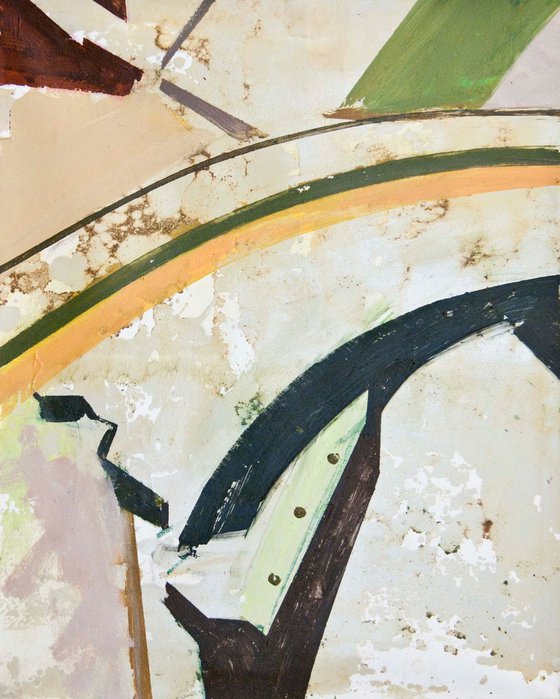- By medium
- By subject
- By budget
- Sales
- Gift cards
- Discover all art
- Artists
- Editors’ picks
- Ideas
Original artwork description:
The work explores the fragmented remains of the aircraft on Higher Shelf Stones landscape.
Using a palette from colour studies of the surrounding landscape with a composition developed from overlaid drawings of the wreckage.
The work pays homage to the tragic loss of the 13 strong crew.
A Brief History.
Boeing B29 Superfortress of the 16th Photographic Reconnaissance Squadron, USAF, crashed at Higher Shelf Stones near Glossop at approximately 11am on 3rd November 1948. Nick-named ‘Over Exposed.
Its thirteen-strong crew perished that night. The crew had completed their tour of duty and would have returned to the States three days later.
It was en route from RAF Scampton near Lincoln to USFA Burtonwood, near Warrington carrying mail and the payroll for American service personnel - a flight of less than one hour. England was covered with low cloud that day and the flight was to be conducted on instruments. Having flown for the time the crew believed it should have taken them to cross the hill they started to descend. Unfortunately, the aircraft had not quite passed the hills and struck the ground near Higher Shelf Stones and was destroyed by fire.
The aircraft was reported missing and the local authorities and nearby RAF Mountain Rescue Service team were put on alert. At the time the MRS team were on a training exercise in the Kinder Scout area about three miles away. They made their way as quickly as possible to the southern side of Bleaklow to begin a search for the crash site. Arriving at the crash site at around 16:30 they discovered that there were no survivors and with the light fading fast left the recovery of the crew until the following morning. The bodies were recovered from 200-yard long debris trail along with a $7,400 pay-satchel the plane was carrying. After the crash investigation teams had finished the tail fin which still stood up-right was destroyed as it could be seen for miles around and was attracting too many sightseers.
Materials used:
Acyclics , Household Paints and Wood Strain
Over Exposed - No 1 (2019) Mixed-media painting
by Ian McKay
5 Artist Reviews
£840
- Mixed-media painting on Canvas
- One of a kind artwork
- Size: 41 x 51 x 3.5cm (unframed) / 41 x 51cm (actual image size)
- Signed on the back
- Style: Abstract
- Subject: Abstract and non-figurative
Loading
Original artwork description
The work explores the fragmented remains of the aircraft on Higher Shelf Stones landscape.
Using a palette from colour studies of the surrounding landscape with a composition developed from overlaid drawings of the wreckage.
The work pays homage to the tragic loss of the 13 strong crew.
A Brief History.
Boeing B29 Superfortress of the 16th Photographic Reconnaissance Squadron, USAF, crashed at Higher Shelf Stones near Glossop at approximately 11am on 3rd November 1948. Nick-named ‘Over Exposed.
Its thirteen-strong crew perished that night. The crew had completed their tour of duty and would have returned to the States three days later.
It was en route from RAF Scampton near Lincoln to USFA Burtonwood, near Warrington carrying mail and the payroll for American service personnel - a flight of less than one hour. England was covered with low cloud that day and the flight was to be conducted on instruments. Having flown for the time the crew believed it should have taken them to cross the hill they started to descend. Unfortunately, the aircraft had not quite passed the hills and struck the ground near Higher Shelf Stones and was destroyed by fire.
The aircraft was reported missing and the local authorities and nearby RAF Mountain Rescue Service team were put on alert. At the time the MRS team were on a training exercise in the Kinder Scout area about three miles away. They made their way as quickly as possible to the southern side of Bleaklow to begin a search for the crash site. Arriving at the crash site at around 16:30 they discovered that there were no survivors and with the light fading fast left the recovery of the crew until the following morning. The bodies were recovered from 200-yard long debris trail along with a $7,400 pay-satchel the plane was carrying. After the crash investigation teams had finished the tail fin which still stood up-right was destroyed as it could be seen for miles around and was attracting too many sightseers.
Materials used:
Acyclics , Household Paints and Wood Strain
14 day money back guaranteeLearn more

